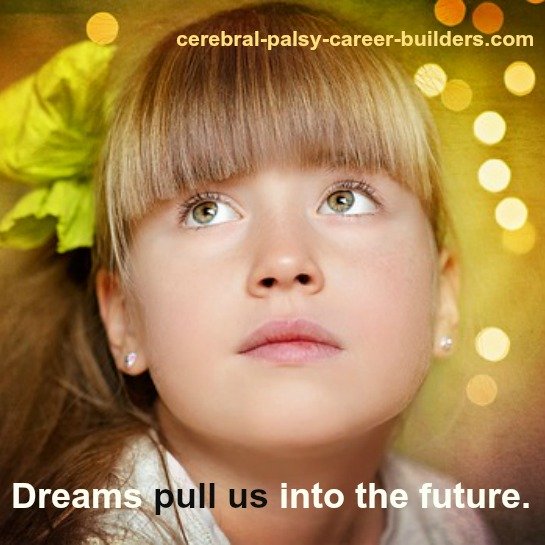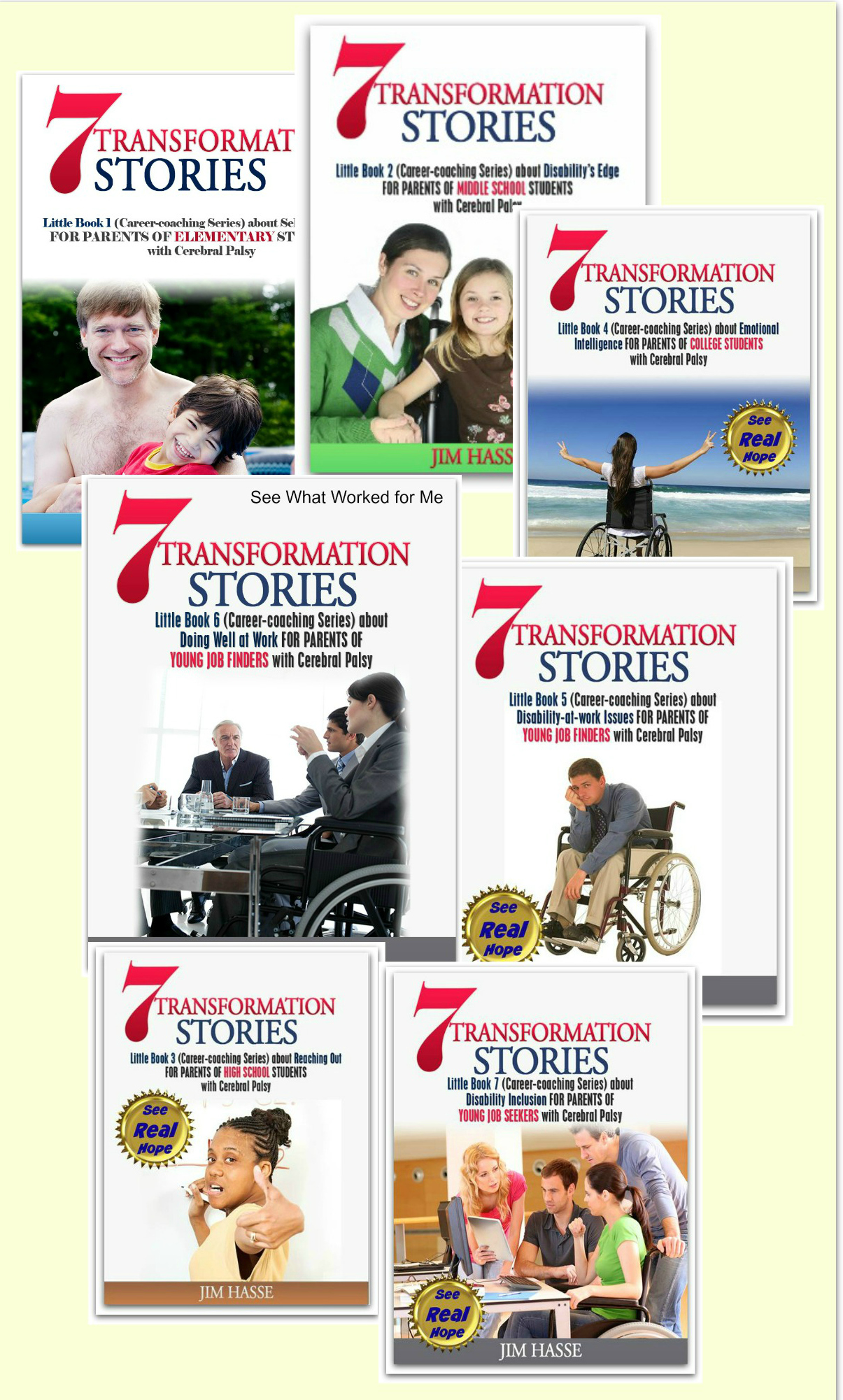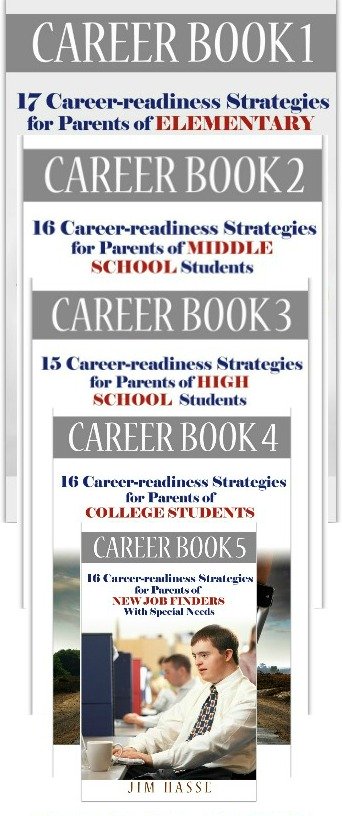Steps
to Setting a Goal: Cerebral Palsy Career Builder for Elementary Students
By Jim Hasse, ABC, GCDF, Disability Employment Expert
_________________________________________________________
Taking deliberate steps to setting a goal didn’t come easy for me.
After two years on the job in 1967, I was ready to “jump ship” from a small, local dairy cooperative in a small town of 279 people in what some called the “arm pit” of Wisconsin. My college roommates were getting good jobs in big cities, while I was stuck in rural Wisconsin where college graduates were the exception.
I combed the help-wanted ads every Sunday in our state-wide newspaper and mailed resume after resume -- all to no avail. As a job seeker with cerebral palsy, I was discouraged.
I wanted to work in Madison, a college town where I attended the University of Wisconsin-Madison and where I could enjoy the arts, socialize with creative people etc. Yet, that dream seemed beyond my reach. I didn’t have a concept in mind about how to realize that dream – about the steps to setting a goal I needed to take.
But, a funny thing happened. The small, local co-op continued to grow, and I soon found myself continually scrambling to keep ahead of changes that, at the time, I didn’t recognize as a major restructuring of the Midwest dairy industry. And, by happenstance, I had landed a “beginner’s” job with the organization which would survive and prevail among more than 20 competitors.
To prepare myself for the changes which were coming at me at increasing speed in my own job, I joined the International Association of Business Communicators and took courses on the Madison campus in business, management, leadership, and communications.
With lots of effort and failure (but also some
success), I prodded senior management (and the new people just out of college
who were beginning to join our growing company) into considering new methods of
communicating with dairy farmer members and managing employees.
Flash forward 20 years
In 1987, I was vice president for corporate communication for the same cooperative. It had become a much larger dairy processing organization with 14 manufacturing plants. Reporting directly to the firm’s CEO, I was involved with developing senior management’s strategy for preparing our employees and dairy farmer owners for an impending consolidation with a major competitor.
We had a central office picnic that summer, and I could feel the excitement about the consolidation among the headquarters employees because the future looked bright for each us. Doubling the size of the organization presented both challenges and opportunities. It had been our vision for a decade.
We even had a new company logo designed, and I had my staff all set to present it to the combined board of directors on the day when a final vote on the deal was to be taken.
I remember our CEO raising the bar especially for me as we danced the “limbo” at the picnic. It didn’t matter that I slithered awkwardly beneath it with my crutches. We all felt like we were part of something bigger than ourselves.
But, then the board of directors failed to approve the consolidation by one vote on what was to be our big day.
Everyone was devastated. I saw my CEO’s long face after the vote. But, he snapped back the next day when I watched him walk by my office with the same confident stride he always had. And, I took my cue from him.
To re-energize my own staff, I positioned the apparent “defeat” as an opportunity to reinforce the strengths we had in the company’s management structure and style. To prepare for next opportunity to accomplish the consolidation, we needed to retrace the steps to setting a goal.
So, over the following
three years, we planned and conducted a corporate-wide communications audit.
And, my staff members stuck with me. We learned the value of taking deliberate
steps to setting a goal. And, in carrying out the recommendations from that communication
audit, we further strengthened the organization.
In 1995, the consolidation proposed eight years earlier was finally
approved, and the corporate logo we originally proposed in 1987 became the
corporate identity for what is now Foremost
Farms USA, a $1.14 billion company which employs 1,000 people and processes
and markets a variety of cheeses, whey ingredients and butter for commercial
customers around the globe.

Flash ahead another 16 years
Pam, my wife, and I are now retired after working online with small companies and non-profits in Los Angles and New York City as well as Wisconsin. We live in a high-rise condo in downtown Madison three blocks from the Capitol on the edge of the University of Wisconsin-Madison campus, and we love it.
My dream in 1967 has come true, largely because I learned how to be patient and how to follow the steps to setting a goal.
Here's the message for your elementary school youngster with CP: You, too, can realize your dreams if you dream big (like George Bailey in “It’s a Wonderful Life”), create a vision for yourself, show your passion, develop patience and connect with people who can influence your future.
That’s also what Dr. Samantha Collins, CEO of Aspire Companies and founder of The Aspire Foundation (a mentorship program for women across 24 countries), recommends. She’s a recognized leadership expert and executive coach.
One of the Top 100 Coaches in the UK, Collins says identifying your big goal is important because your dreams are your fuel. They motivate you.
She’s not a big fan of SMART goals (those which are “specific, measurable, achievable, relevant and time-framed”). She recommends, instead, “developing more of a vision, going to your highest level.”
She adds, “You don’t have to be realistic at this stage. Your vision should invoke excitement as well as slight terror -- terror because you’re clueless about how you’re going to pull it all off. All the planning can come later.”
That may be just the right touch for youngster with CP, who is now ready to learn about steps to setting a goal.
Develop a dream board
Collins reminds us that, in order to achieve, your
youngster needs to fail and learn how to get up and try again. Learning how to
live with failure develops persistence, agility and resiliency -- all key
attributes employers seek in job candidates.
Your youngster develops that persistence, agility and
resiliency by learning how to bounce back quickly in the face of adversity (in
minutes -- or in a day at the maximum), Collins points out. “Go to the next
level of deciding what to do differently next time and then practice so you
really do it differently,” she recommends.
In other words, being authentic and knowing what you
need to know to do better next time will draw people to you who can help your
realize your dream. That advice about steps to setting a goal applies to not
only your youngster but to you, as a “career coach.”
Thinking “I’m lucky” or “I’m a super person” are both
pitfalls because when some things don’t work out like you had hoped (and that
will most likely happen along the way as you career coach your youngster), you
can easily start thinking, “I’m a fraud,” Collins points out. In other words,
true personal power is being comfortable with yourself and your capabilities --
being authentic.
Develop a ‘dream board’ for pulling your youngster
into the future, she recommends. You can do that together by following these
steps to setting a goal of making a dream that may seem fuzzy more concrete and
obtainable:
- Create a collage of magazine pictures, newspaper
headlines etc. which resonate with your youngster because they illustrate, in
concrete terms, what his or her dream is all about.
- Make sure your youngster puts him or herself in the center of that dream board.
- Place it in a location where you both can see it
frequently on a daily basis.
- Take one small, achievable action toward your youngster’s
dream within 24 hours of creating the dream board so you both feel like you’re
already a part of it.
- Work together toward making your youngster’s dream
board come true, one step at a time, perhaps with the help of his or her
teacher.
- Go onto a new dream board when your youngster has accomplished what was first envisioned.
By
following that process, Collins asserts, you’ll both get to know yourselves
better and learn that preparing for an eventual career is a long process of
small steps to setting a goal.
How helpful is this activity?
Share your quick assessment, and you'll immediately get the poll's overall results by e-mail.
Return
from Steps to Setting a Goal to Job Titles
Go to Cerebral Palsy Career Builders
This is Creative Commons content. You can freely and legally use, share and repurpose it for non-commercial purposes only, provided you attach this sentence and the following attribution to it (including the two links):
Originally written and illustrated by Jim Hasse, ABC, GCDF, owner of Hasse Communication Counseling, LLC, who, as a person with cerebral palsy, served for 10 years as a vice president in a Fortune 500 company during his 29-year career in corporate communication. He’s an Accredited Business Communicator, certified as a Global Career Development Facilitator and author of 14 Amazon books about disability awareness and disability employment issues.





